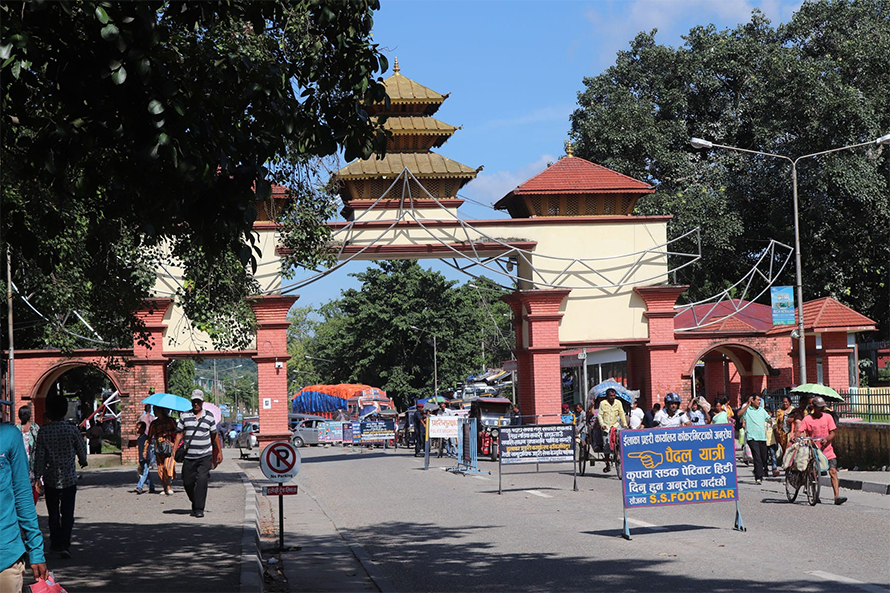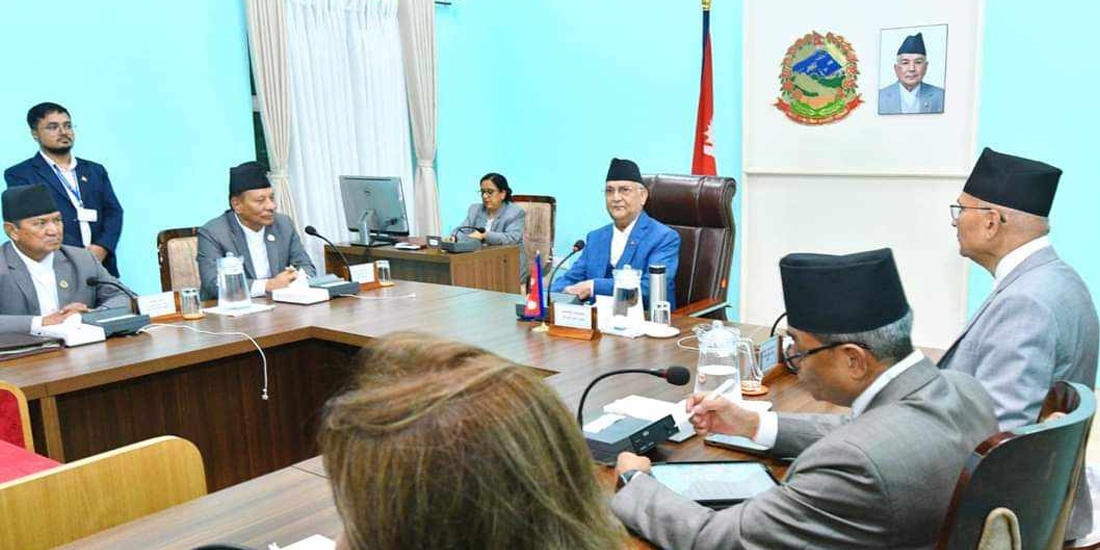Three years of Oli Government: A Review
 NepalPress
NepalPress

KATHMANDU: Coincidentally, Prime Minister KP Sharma Oli, who has been criticized for not attending office for a long time, inaugurated his office at Singha Durbar on the occasion of the three-year anniversary of his government.
After the inauguration of the reconstructed Singha Durbar building, the Office of the Prime Minister and the Council of Ministers has come into operation from the main building of Singha Durbar as before the catastrophic earthquake.
In a way, this is a sign that the reconstruction post the catastrophic earthquake of 2072 is about to enter its final stage.
Below are the achievements of the Oli-led government of the past 3 years.
Reconstruction
Due to the politics of who will get the Chief Executive Officer (CEO) of the National Reconstruction Authority, the post-earthquake reconstruction had not accelerated for a long time. Before the formation of the government led by KP Sharma Oli after the House of Representatives elections, the politics of who would be the CEO of the NRA between the Congress and the then UML continued. Reconstruction did not gain momentum with the game of Congress electing Govinda Raj Pokhrel and the then UML government electing and removing Sushil Gyawali.
However, after the Oli-led government was formed after the House of Representatives elections, the CEO politics took a break. NRA chief Gyawali returned to leadership and was able to move forward smoothly and with confidence. Reconstruction, which had been delayed by party politics, has since gained momentum.
Reconstruction of Singha Durbar is being completed and it has been inaugurated. The government has said that the construction of Dharahara will be completed in four months. Important archaeological structures including Ranipokhari, Durbar High School and Basantapur Durbar have also been reconstructed.
Reconstruction work of 565 properties has been completed so far. Only 80 archaeological sites were completed three years ago. The construction of 559,461 houses has also been completed.
Law-making
Within a year of the first session of the federal parliament, laws that conflicted with the constitution would automatically become invalid, so it was the government’s responsibility to draft those laws and regulations.
Even though the new constitution was promulgated by the Constituent Assembly, there was a need to govern through the existing 315 acts and 200 regulations.
The provision that if existing laws that are in conflict with the constitution within one year of the first session of the federal parliament will automatically become invalid had increased pressure on the government.
In the first year, a bill drafted with 25 laws, including 16 laws related to the implementation of fundamental rights, was passed by the federal parliament in approximately five days. In the second year, 30 new laws were enacted and in the third year, 34 were enacted. In total, 89 new laws were formulated and hundreds of laws that contradicted the constitution were amended.
Due to the inability to reach political consensus on some important acts such as the Citizenship Act, they remain inconclusive.
Foreign Relations and the new Map
The government claims that it has made the country’s foreign policy ‘visible and heard’, which had been lost in the shadows due to long political instability and transition.
Attempts were also made to do something hopeful in the field of diplomacy in the space of three years. The issuance of a map against Indian encroachment including Kalapani, Lipulekh and Limpiyadhura, can be considered as an achievement as it brought all political forces together. However, the issue of maintaining its real ownership remains.
After the transit agreement with China, Nepal’s status has changed from landlocked to a country with sea access.
Diplomatic relations have been established with 12 more countries and the number of countries with established diplomatic relations with Nepal has reached 168.
The Prime Minister was summoned to the Davos Forum for the first time. In the meantime, Prime Minister Oli was able to complete his long-delayed visit to Europe and other regions. Prime Minister Oli visited the United Kingdom, France, Switzerland, Myanmar and Cambodia.
Similarly, Foreign Minister Pradip Gyawali paid an official visit to the United States after 17 years. After 14 years of formal visits to old friendly countries like Japan and Russia, he tried to renew the relationship. There were also some visits from counterparts.
The Chinese President visited Nepal after 23 years. Diplomatic exchanges increased comparatively, to an extent.
For the first time, a new foreign policy was issued. The government’s Everest dialogue had to be halted due to the COVID pandemic. The new height of Mount Everest has also been made public, which has helped dispel misconceptions.
Governance and Development
By announcing the reduction of transport syndicates and trying to issue a policy of integrity, the government was initially signalling a strong move towards good governance. The investigation into the Lalita Niwas case, 33 gold scandals and the Wide Body case were carried out during these three years. However, the government did not meet the expectations in this area.
In the meantime, important works have been done in the field of infrastructure. Construction of Nepal-India Petroleum Pipeline has been completed. Construction of tunnels has begun. The Nagdhunga-Naubise, Betrawati-Syafrubesi, Tokha-Chhare, Siddhababa, Thankot-Chitlang, Kathmandu-Hetauda, Khurkot-Chiabari and Fedikhola-Nayapul tunnels have been inaugurated.
Similarly, preliminary work of the East-West Railway, Rasuwagadhi-Kathmandu-Pokhara -Lumbini Railway and Birgunj-Kathmandu Railway has also started.
Prime Minister’s Employment Program and miscellaneous
In the context of the Constitution of Nepal establishing employment as a fundamental right, the government in the meantime launched the implementation of the Prime Minister’s Employment Program. The government claims that many young people have benefited from this. However, this is not without controversy.
The government has also launched a social security program. An additional citizen pension program has also been implemented through the Citizens Investment Fund so that those who are affiliated with the Social Security Fund can also participate. This is expected to help implement the concept of a welfare state.
Meanwhile, the government has brought CK Raut who is involved in the separatist campaign, into peaceful politics through talks. Political talks are also underway with the conflicting parties.
OLI’S MISFIRES
As the government completes its third year, Oli neither has a ‘House of Representatives’, nor an answer to what happened to the foundation, beginning and continuation of a period of prosperity for Nepalese citizens. Prime Minister Oli, who has been claiming that his government has been formed on a strong foundation and not on “short-term” and “weak support”, is now preparing for the midterm elections.
The House of Representatives is currently dissolved as a result of internal strife within the Communist Party of Nepal (CPN). Prime Minister Oli is celebrating the third anniversary of the government’s rule as his former allies take to the streets to protest.
This is a very sensitive time for Prime Minister Oli, who has announced a fresh mandate by dissolving the House of Representatives elected for five years. What is the future of Oli’s conclusion that a two-thirds government over a simple majority is inevitable? It is not possible to say right now.
But the weakness of the Oli-led government in three years can be attributed to today’s ‘political/constitutional crisis’.
What have been the main weaknesses of the government in these three years?
Inability to maintain stability
In the election held in December 2017, the slogan of the Left Alliance was: Political Stability. In the past, during parliamentary practice, no government was allowed to work full time. The Left Alliance had promised to form a strong and permanent government for a full five-year term.
After being approved by the people, Oli led the campaign to fulfil this promise by becoming the Prime Minister. But this campaign for stability has stalled. Whatever the reason, the seeds of political instability have been sown.
Prime Minister Oli has failed to run the government for the entire term. Prime Minister Oli, who felt more non-cooperation from within the party, has failed to deliver on his commitment to stability since the dissolution of the House of Representatives on December 20. Although the people searched for a government that would last for five years, the government failed to save it.
Road to prosperity still closed
The slogan ‘Prosperous Nepal, Happy Nepali’ makes it clear that prosperity was the main priority of the government. Prime Minister Oli’s every public speech was adorned with the dream of prosperity. However, prosperity did not materialize during this three-year period.
Prosperity is a continuous process, although it has not reached the level that people experience. The government has acknowledged the need for “one more election and two-thirds majority” for prosperity.
The construction of large projects, laying of foundation stones or announcements alone are not enough for prosperity. In three years, the government’s campaigns and programs that have been declared the cornerstone of prosperity have not been successful.
Despite being seen as a high priority of the government on the cover, prosperity is still a far cry from the people’s perspective.
Question on Good Governance
Good governance was one of Prime Minister Oli’s key announcements. The belief that a strong permanent government will guarantee good governance by ending the distortions seen in various parts of the country is gradually declining.
The significance of good governance seems to have shifted further as the very essence of political stability seems to be incomplete. Issues such as the Baluwatar land case, the Wide Body scandal, the gold scandal, the audio tape case, and the health material procurement case that came to the fore during this period continued to raise questions about good governance.
It is clear that the slogan of good governance has not been implemented in three years due to the inability to give satisfactory answers to these questions.
Failed Internal Management
It is said that the government will not succeed only by getting people’s votes. The fact that the power of public vote is ‘fleeting’ due to failure in internal management was proved in just three years. Prime Minister Oli, along with the role of CPN Chairperson failed in internal management.
Prime Minister Oli has been forced to announce a fresh mandate through the dissolution of the House of Representatives as he seems uncomfortable addressing the ongoing dissatisfaction within the party. The failure to properly manage the infighting within the CPN since the formation of the government is a failure of the current government’s three-year tenure.
It is natural for the evaluation of a democratically elected government to be sidelined by democratic methods. However, there is a need for continuous evaluation and public scrutiny of government work.
Despite succeeding in making citizens dream of prosperity, it has wasted three years due to its involvement in internal political management. The announcement of a government with a fresh mandate is the beginning of a new chapter incapable of government formation in Nepal.
However, the fact that the government does not succeed only on the strength of the majority has been proved by the Oli government in these three years.














